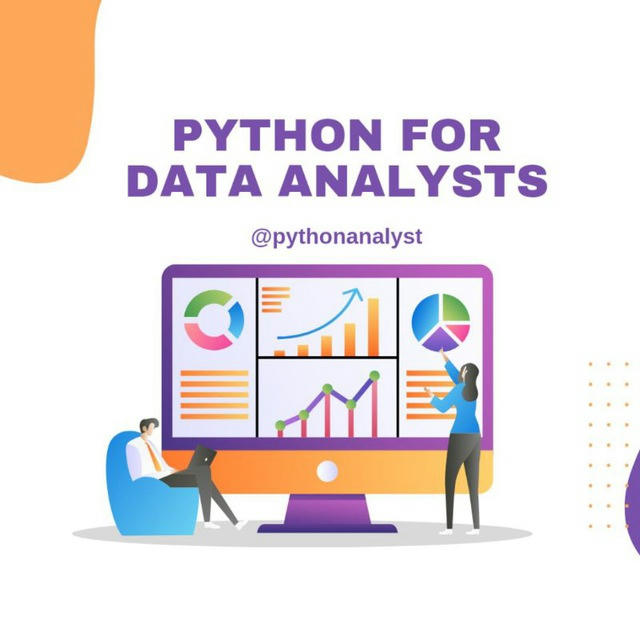
Python for Data Analysts
Python for Data Analysts Admin: @Guideishere12
Больше28 022
Подписчики
+14124 часа
+8847 дней
+3 24430 дней
- Подписчики
- Просмотры постов
- ER - коэффициент вовлеченности
Загрузка данных...
Прирост подписчиков
Загрузка данных...
📈 Predictive Modeling for Future Stock Prices in Python: A Step-by-Step Guide
The process of building a stock price prediction model using Python.
1. Import required modules
2. Obtaining historical data on stock prices
3. Selection of features.
4. Definition of features and target variable
5. Preparing data for training
6. Separation of data into training and test sets
7. Building and training the model
8. Making forecasts
9. Trading Strategy Testing
Jupyter Notebooks are essential for data analysts working with Python.
Here’s how to make the most of this great tool:
1. 𝗢𝗿𝗴𝗮𝗻𝗶𝘇𝗲 𝗬𝗼𝘂𝗿 𝗖𝗼𝗱𝗲 𝘄𝗶𝘁𝗵 𝗖𝗹𝗲𝗮𝗿 𝗦𝘁𝗿𝘂𝗰𝘁𝘂𝗿𝗲:
Break your notebook into logical sections using markdown headers. This helps you and your colleagues navigate the notebook easily and understand the flow of analysis. You could use headings (#, ##, ###) and bullet points to create a table of contents.
2. 𝗗𝗼𝗰𝘂𝗺𝗲𝗻𝘁 𝗬𝗼𝘂𝗿 𝗣𝗿𝗼𝗰𝗲𝘀𝘀:
Add markdown cells to explain your methodology, code, and guidelines for the user. This Enhances the readability and makes your notebook a great reference for future projects. You might want to include links to relevant resources and detailed docs where necessary.
3. 𝗨𝘀𝗲 𝗜𝗻𝘁𝗲𝗿𝗮𝗰𝘁𝗶𝘃𝗲 𝗪𝗶𝗱𝗴𝗲𝘁𝘀:
Leverage ipywidgets to create interactive elements like sliders, dropdowns, and buttons. With those, you can make your analysis more dynamic and allow users to explore different scenarios without changing the code. Create widgets for parameter tuning and real-time data visualization.
𝟰. 𝗞𝗲𝗲𝗽 𝗜𝘁 𝗖𝗹𝗲𝗮𝗻 𝗮𝗻𝗱 𝗠𝗼𝗱𝘂𝗹𝗮𝗿:
Write reusable functions and classes instead of long, monolithic code blocks. This will improve the code maintainability and efficiency of your notebook. You should store frequently used functions in separate Python scripts and import them when needed.
5. 𝗩𝗶𝘀𝘂𝗮𝗹𝗶𝘇𝗲 𝗬𝗼𝘂𝗿 𝗗𝗮𝘁𝗮 𝗘𝗳𝗳𝗲𝗰𝘁𝗶𝘃𝗲𝗹𝘆:
Utilize libraries like Matplotlib, Seaborn, and Plotly for your data visualizations. These clear and insightful visuals will help you to communicate your findings. Make sure to customize your plots with labels, titles, and legends to make them more informative.
6. 𝗩𝗲𝗿𝘀𝗶𝗼𝗻 𝗖𝗼𝗻𝘁𝗿𝗼𝗹 𝗬𝗼𝘂𝗿 𝗡𝗼𝘁𝗲𝗯𝗼𝗼𝗸𝘀:
Jupyter Notebooks are great for exploration, but they often lack systematic version control. Use tools like Git and nbdime to track changes, collaborate effectively, and ensure that your work is reproducible.
7. 𝗣𝗿𝗼𝘁𝗲𝗰𝘁 𝗬𝗼𝘂𝗿 𝗡𝗼𝘁𝗲𝗯𝗼𝗼𝗸𝘀:
Clean and secure your notebooks by removing sensitive information before sharing. This helps to prevent the leakage of private data. You should consider using environment variables for credentials.
Keeping these techniques in mind will help to transform your Jupyter Notebooks into great tools for analysis and communication.
👍 13
Repost from Data Engineering Books
Complete Python topics required for the Data Engineer role:
➤ 𝗕𝗮𝘀𝗶𝗰𝘀 𝗼𝗳 𝗣𝘆𝘁𝗵𝗼𝗻:
- Python Syntax
- Data Types
- Lists
- Tuples
- Dictionaries
- Sets
- Variables
- Operators
- Control Structures:
- if-elif-else
- Loops
- Break & Continue try-except block
- Functions
- Modules & Packages
➤ 𝗣𝗮𝗻𝗱𝗮𝘀:
- What is Pandas & imports?
- Pandas Data Structures (Series, DataFrame, Index)
- Working with DataFrames:
-> Creating DFs
-> Accessing Data in DFs Filtering & Selecting Data
-> Adding & Removing Columns
-> Merging & Joining in DFs
-> Grouping and Aggregating Data
-> Pivot Tables
- Input/Output Operations with Pandas:
-> Reading & Writing CSV Files
-> Reading & Writing Excel Files
-> Reading & Writing SQL Databases
-> Reading & Writing JSON Files
-> Reading & Writing - Text & Binary Files
➤ 𝗡𝘂𝗺𝗽𝘆:
- What is NumPy & imports?
- NumPy Arrays
- NumPy Array Operations:
- Creating Arrays
- Accessing Array Elements
- Slicing & Indexing
- Reshaping, Combining & Arrays
- Arithmetic Operations
- Broadcasting
- Mathematical Functions
- Statistical Functions
➤ 𝗕𝗮𝘀𝗶𝗰𝘀 𝗼𝗳 𝗣𝘆𝘁𝗵𝗼𝗻, 𝗣𝗮𝗻𝗱𝗮𝘀, 𝗡𝘂𝗺𝗽𝘆 are more than enough for Data Engineer role.
Data Engineering Interview Preparation Resources: https://topmate.io/analyst/910180
All the best 👍👍
👍 15❤ 1
Use Python to turn messy data into valuable insights!
Here are the main functions you need to know:
1. 𝗱𝗿𝗼𝗽𝗻𝗮(): Clean up your dataset by removing missing values. Use df.dropna() to eliminate rows or columns with NaNs and keep your data clean.
2. 𝗳𝗶𝗹𝗹𝗻𝗮(): Replace missing values with a specified value or method. With the help of df.fillna(value) you maintain data integrity without losing valuable information.
3. 𝗱𝗿𝗼𝗽_𝗱𝘂𝗽𝗹𝗶𝗰𝗮𝘁𝗲𝘀(): Ensure your data is unique and accurate. Use df.drop_duplicates() to remove duplicate rows and avoid skewing your analysis by aggregating redundant data.
4. 𝗿𝗲𝗽𝗹𝗮𝗰𝗲(): Substitute specific values throughout your dataset. The function df.replace(to_replace, value) allows for efficient correction of errors and standardization of data.
5. 𝗮𝘀𝘁𝘆𝗽𝗲(): Convert data types for consistency and accuracy. Use the cast function df['column'].astype(dtype) to ensure your data columns are in the correct format you need for your analysis.
6. 𝗮𝗽𝗽𝗹𝘆(): Apply custom functions to your data. df['column'].apply(func) lets you perform complex transformations and calculations. It works with both standard and lambda functions.
7. 𝘀𝘁𝗿.𝘀𝘁𝗿𝗶𝗽(): Clean up text data by removing leading and trailing whitespace. Using df['column'].str.strip() helps you to avoid hard-to-spot errors in string comparisons.
8. 𝘃𝗮𝗹𝘂𝗲_𝗰𝗼𝘂𝗻𝘁𝘀(): Get a quick summary of the frequency of values in a column. df['column'].value_counts() helps you understand the distribution of your data.
9. 𝗽𝗱.𝘁𝗼_𝗱𝗮𝘁𝗲𝘁𝗶𝗺𝗲(): Convert strings to datetime objects for accurate date and time manipulation. For time series analysis the use of pd.to_datetime(df['column']) will often be one of your first steps in data preparation.
10. 𝗴𝗿𝗼𝘂𝗽𝗯𝘆(): Aggregates data based on specific columns. Use df.groupby('column') to perform operations like sum, mean, or count on grouped data.
Learn to use these Python functions, to be able to transform a pile of messy data into the starting point of an impactful analysis.
👍 16❤ 4👏 2
Python — Using reduce()
The reduce() function is a powerful tool from Python's functools module. It allows you to apply a function cumulatively to the items of a sequence, from left to right, reducing the sequence to a single value
👍 10
Показать все...
Data Analytics on LinkedIn: Complete roadmap to learn Python for beginners: 👇👇
🔹Understand Basics:…
Complete roadmap to learn Python for beginners: 👇👇 🔹Understand Basics: Start with Python syntax, variables, and basic data types. Learn about control flow…
👍 5
import_data.pdf1.35 KB
jupyter.pdf7.85 KB
numpy_basics.pdf6.49 KB
pandas.pdf1.86 KB
pandas_basics.pdf6.84 KB
python_basics.pdf2.12 KB
❤ 15👍 5👏 1
5 key Python Libraries/ Concepts that are particularly important for Data Analysts
1. Pandas: Pandas is a powerful library for data manipulation and analysis in Python. It provides data structures like DataFrames and Series that make it easy to work with structured data. Pandas offers functions for reading and writing data, cleaning and transforming data, and performing data analysis tasks like filtering, grouping, and aggregating.
2. NumPy: NumPy is a fundamental package for scientific computing in Python. It provides support for large, multi-dimensional arrays and matrices, along with a collection of mathematical functions to operate on these arrays efficiently. NumPy is often used in conjunction with Pandas for numerical computations and data manipulation.
3. Matplotlib and Seaborn: Matplotlib is a popular plotting library in Python that allows you to create a wide variety of static, interactive, and animated visualizations. Seaborn is built on top of Matplotlib and provides a higher-level interface for creating attractive and informative statistical graphics. These libraries are essential for data visualization in data analysis projects.
4. Scikit-learn: Scikit-learn is a machine learning library in Python that provides simple and efficient tools for data mining and data analysis tasks. It includes a wide range of algorithms for classification, regression, clustering, dimensionality reduction, and more. Scikit-learn also offers tools for model evaluation, hyperparameter tuning, and model selection.
5. Data Cleaning and Preprocessing: Data cleaning and preprocessing are crucial steps in any data analysis project. Python offers libraries like Pandas and NumPy for handling missing values, removing duplicates, standardizing data types, scaling numerical features, encoding categorical variables, and more. Understanding how to clean and preprocess data effectively is essential for accurate analysis and modeling.
By mastering these Python concepts and libraries, data analysts can efficiently manipulate and analyze data, create insightful visualizations, apply machine learning techniques, and derive valuable insights from their datasets.
👍 11
Выберите другой тариф
Ваш текущий тарифный план позволяет посмотреть аналитику только 5 каналов. Чтобы получить больше, выберите другой план.

 Network:
Network: